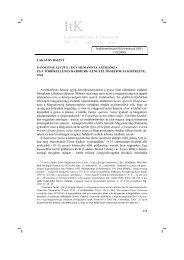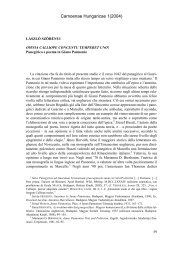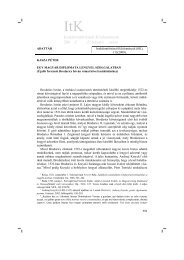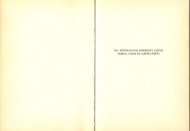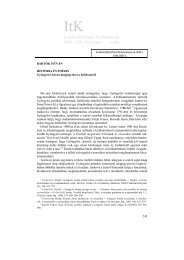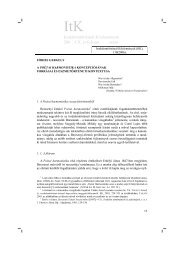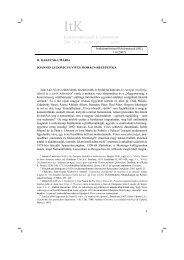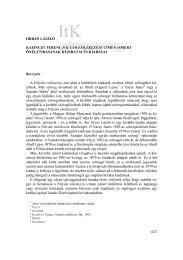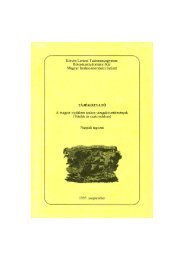Camoenae Hungaricae 3(2006) - Irodalomtörténeti Közlemények
Camoenae Hungaricae 3(2006) - Irodalomtörténeti Közlemények
Camoenae Hungaricae 3(2006) - Irodalomtörténeti Közlemények
You also want an ePaper? Increase the reach of your titles
YUMPU automatically turns print PDFs into web optimized ePapers that Google loves.
of this background material, would provide an opportunity for an analysis in this direction.<br />
In fact I think it is on the basis of the background material that we could analyse and<br />
resolve the problem of the “reuniting the two Marsilis.”<br />
There has been only one effort of this kind, one that aimed at painting a complete picture<br />
of this complex personality: the excellent Marsili biography by John Stoye, 18 in<br />
which the author, whose grasp of the traditional genre is enhanced by his reasoned methodology,<br />
presented the Bolognese count in the way he himself had wanted to be seen—<br />
“miles sum” (I am a soldier), he introduced himself before the Royal Society in London.<br />
19 However, this monograph also admits to having focused on the politically active<br />
years of Marsili and to having treated the last decades in a sketchy manner and only for<br />
the sake of completeness. 20 It also left two fundamental questions open. One of these is<br />
the scholar vs soldier/politician/diplomat dilemma (which of these he really was, to what<br />
extent and in what periods) and the other is the “missing” emotional life of Marsili with<br />
all its attendant implications. True, he provides an implicit answer for both questions. For<br />
one thing, biography as a genre almost automatically implies consecutive stages in<br />
time—i.e. first mostly a soldier, later mostly a scholar. Furthermore, Stoye is not concerned<br />
with the emotional life of his hero because he felt there was nothing to explore<br />
there: “…a personage quickly attracting notice wherever he went. Perhaps he enjoyed<br />
such superlative energy because other thing were missing. We have not found evidence<br />
of his sexuality or lack of it; of any wish to father a family or maintain a noble household.”<br />
21 For all its cautious reservations, this statement obviously suggests that Marsili<br />
was a soldier free of passions, a sober bureaucrat free of national prejudices and a<br />
scholar unencumbered with a family—which, again, offers a kind of implicit solution to<br />
the problem.<br />
In the following, I would like to propose some new hypotheses in relation to these two<br />
issues. It is my conviction that the organisation of the Marsili papers—or their present<br />
state of disorganisation—is closely connected with the hitherto unexplored, unanalyzed<br />
aspects of the author’s personality. The contours of the “unknown” Marsili, which I believe<br />
to have found, were starting to take shape for me when I discarded the interpretative<br />
scheme “first a soldier, then a scholar” and started to look for political motivations in<br />
Marsili’s late, scientific texts. Perhaps it would help in our further thinking if we tried to<br />
find a common name for the two vocations. Marsili, in my considered opinion, was a spy.<br />
18<br />
John STOYE, Marsigli’s Europe 1680–1730: The Life and Times of Luigi Ferdinando Marsigli Soldier<br />
and Virtuoso, New Haven–London, 1994. As for Hungarian works, we should mention the old monograph by<br />
BELICZAY Jónás (Marsigli élete és munkái [The life and works of Marsigli], Budapest, 1881), and two recent<br />
studies: GRÓF László, Marsigli gróf élete (The life of count Marsigli), Cartographia Hungarica, 2(1992),<br />
3(1993), 4(1996); and JÁSZAY Magda, Marsili a katona, diplomata és tudós Magyarországon a török kor<br />
alkonyán (Marsili, the soldier, diplomat and scholar in Hungary at the fall of the Turkish occupation), Történelmi<br />
Szemle, 41(1999), 31–52.<br />
19<br />
Aloysius Ferdinandus Comit. MARSIGLI, Danubialis Operis Prodromus, ad Regiam Societatem Anglicanam,<br />
Nürnberg, 1700, A2v.<br />
20<br />
STOYE 1994, op. cit., 342.<br />
116<br />
21 Ibid., 309.<br />
<strong>Camoenae</strong> <strong>Hungaricae</strong> 3(<strong>2006</strong>)



